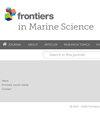Using stochastically generated skewed distributions to represent hourly nontidal residual water levels at United States tide gauges
IF 3
2区 生物学
Q1 MARINE & FRESHWATER BIOLOGY
引用次数: 0
Abstract
The daily likelihood of High Tide Flooding (HTF) predicted by the National Oceanic and Atmospheric Administration (NOAA) for leads up to one year is expressed as the sum of a long-term trend, tides, and nontidal residuals (NTRs) whose probability density functions (PDFs) are assumed to be Gaussian (i.e., normally distributed). We analyzed observed detrended hourly NTR distributions at 148 NOAA tide gauges along the U.S. coastline and show that 98.7% of them are better characterized by ‘Stochastically Generated Skewed’ (SGS) distributions, a class of non-Gaussian (skewed, heavy-tailed) PDFs. In contrast to other methods that generate PDFs by fitting observed raw histograms, SGS distributions are determined through time series analysis. Observations are fit to a simple linear (autoregressive) time series model, driven by stochastic noise with a linear dependence upon the NTR anomaly. The PDF is then determined from the fitted model parameters. The SGS distributions improve upon the Gaussian PDF high-water probabilities at varying thresholds throughout the year along all U.S. coasts, with significantly better estimates along the U.S. East and Gulf coasts during summer (apart from large hurricane events) and along the U.S. West Coast during winter (even though variability there is often dominated by monthly time scales and many locations have nearly Gaussian PDFs). For evaluating extreme high-water event probabilities, the SGS distribution is no more sensitive to limited observations than kernel density estimation or Generalized Extreme Value methods. Tail probabilities for all three methods are generally similar. Our results may contribute to more robust and accurate HTF forecasts and, more broadly, provide additional insight in developing adaptation and mitigation strategies for future sea level conditions.使用随机产生的倾斜分布来表示美国潮汐计每小时的非潮汐剩余水位
美国国家海洋和大气管理局(NOAA)预测的长达一年的涨潮洪水(HTF)的每日可能性表示为长期趋势,潮汐和非潮汐残差(NTRs)的总和,其概率密度函数(pdf)假设为高斯分布(即正态分布)。我们分析了沿美国海岸线148个NOAA潮汐计观测到的逐小时NTR无趋势分布,发现其中98.7%的数据更符合“随机生成偏态”(SGS)分布,这是一类非高斯(偏态,重尾)pdf。与其他通过拟合观察到的原始直方图生成pdf的方法不同,SGS分布是通过时间序列分析确定的。观测结果拟合到一个简单的线性(自回归)时间序列模型,该模型由随机噪声驱动,与NTR异常线性相关。然后根据拟合的模型参数确定PDF。SGS分布改善了全年沿美国所有海岸不同阈值的高斯PDF高水位概率,夏季沿美国东部和墨西哥湾沿岸(除了大型飓风事件)和冬季沿美国西海岸(尽管变化通常由月时间尺度主导,许多地点的PDF接近高斯)的估计明显更好。对于评估极端高水位事件概率,SGS分布并不比核密度估计或广义极值方法对有限观测值更敏感。这三种方法的尾部概率通常是相似的。我们的结果可能有助于更可靠和准确的高温天气预报,并在更广泛的范围内,为制定针对未来海平面条件的适应和缓解战略提供额外的见解。
本文章由计算机程序翻译,如有差异,请以英文原文为准。
求助全文
约1分钟内获得全文
求助全文
来源期刊

Frontiers in Marine Science
Agricultural and Biological Sciences-Aquatic Science
CiteScore
5.10
自引率
16.20%
发文量
2443
审稿时长
14 weeks
期刊介绍:
Frontiers in Marine Science publishes rigorously peer-reviewed research that advances our understanding of all aspects of the environment, biology, ecosystem functioning and human interactions with the oceans. Field Chief Editor Carlos M. Duarte at King Abdullah University of Science and Technology Thuwal is supported by an outstanding Editorial Board of international researchers. This multidisciplinary open-access journal is at the forefront of disseminating and communicating scientific knowledge and impactful discoveries to researchers, academics, policy makers and the public worldwide.
With the human population predicted to reach 9 billion people by 2050, it is clear that traditional land resources will not suffice to meet the demand for food or energy, required to support high-quality livelihoods. As a result, the oceans are emerging as a source of untapped assets, with new innovative industries, such as aquaculture, marine biotechnology, marine energy and deep-sea mining growing rapidly under a new era characterized by rapid growth of a blue, ocean-based economy. The sustainability of the blue economy is closely dependent on our knowledge about how to mitigate the impacts of the multiple pressures on the ocean ecosystem associated with the increased scale and diversification of industry operations in the ocean and global human pressures on the environment. Therefore, Frontiers in Marine Science particularly welcomes the communication of research outcomes addressing ocean-based solutions for the emerging challenges, including improved forecasting and observational capacities, understanding biodiversity and ecosystem problems, locally and globally, effective management strategies to maintain ocean health, and an improved capacity to sustainably derive resources from the oceans.
 求助内容:
求助内容: 应助结果提醒方式:
应助结果提醒方式:


